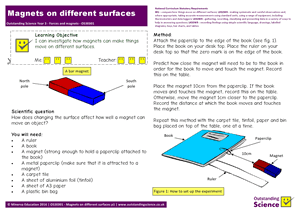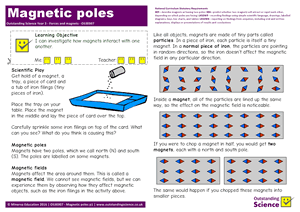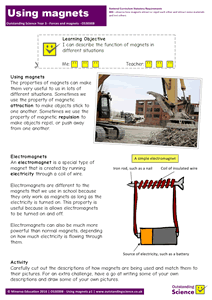

I can investigate how magnetic forces act through different materials.
Children investigate which objects and materials will prevent a paperclip from being attracted to a magnet when placed between them. They attempt to identify the main material each object is made from. They use their results to complete a Venn diagram containing a single set. They attempt to explain their findings.
I can investigate how magnets can make things move on different surfaces.
Children investigate how magnets can make objects move on different surfaces. They attach a metal paperclip to a book and investigate how placing it on different surfaces affects how easily a magnet can move it. They record their predictions and measurements in a table, and then transfer their results to a bar chart.

2 pages
I can investigate how magnetic forces act at a distance.
Children investigate how powerful 5 different magnets are. They predict and then measure the distance at which each magnet will attract a paperclip, recording their results in a table. They transfer their results to a bar chart and place the magnets in order of strength.

2 pages
I can investigate which materials are magnetic.
Children carry out an investigation to find out which classroom objects are magnetic. They consider what they are going to measure and how to make their test fair. Children predict and measure which classroom objects are magnetic. They transfer their results to a 2-dimensional Carroll diagram, showing both which objects were magnetic and which were made of metal. They attempt to find a pattern in their results.

2 pages
I can investigate which metals are magnetic.
Children investigate which metal classroom objects are also magnetic. They think about how they will make their test fair. Children place their results in a Venn diagram containing 2 overlapping sets, and think about in which of the 4 areas to place each result. They discuss the relationship between the type of metal an object is composed of and whether it is magnetic.

3 pages
I can investigate which magnet is the most powerful.
Children carry out an investigation to test the strength of up to 10 magnets. They predict and then measure how many 1p coins they can place in a bag held by a paper clip attracted by the magnet before the bag and paper clip fall off. Children transfer their results to a bar chart and place the magnets in order of strength.

2 pages
I can investigate how magnets interact with one another.
Children investigate whether the poles from two magnets will attract or repel each other when brought together. They record their results in a 2-dimensional Carroll diagram.

2 pages
I can describe the function of magnets in different situations.
Children learn about 5 different machines that use magnets (a maglev train, an MRI machine, a crane, a button magnet, and a compass) and match their images to their descriptions. For an added challenge, children write descriptions in their own words.

3 pages